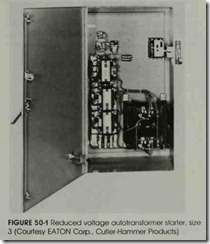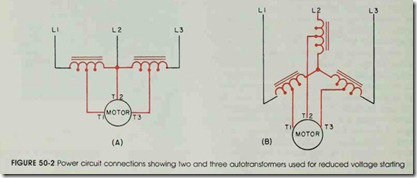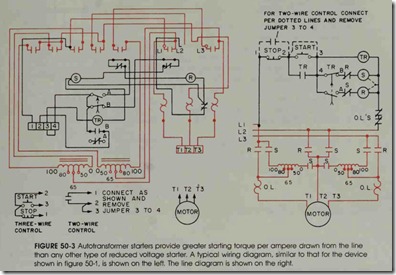Objectives
After studying this unit, the student will be able to:
• Describe the construction and operation of autotransformer starters
• Draw and interpret diagrams for autotransformer starters
• Connect squirrel cage motors to autotransformer starters
• Define what is meant by open transition and closed transition starting
• Troubleshoot electrical problems on autotransformer starters
Autotransformer reduced voltage starters are similar to primary resistor starters in that they are used primarily with ac squirrel cage motors to limit the inrush current or to lessen the starting strain on driven machinery, figure SO-l. This type of starter uses autotransformers between the mo tor and the supply lines to reduce the motor start ing voltage. Taps are provided on the autotrans former to permit the user to start the motor at approximately SO%, 6S%, or 80% of line voltage.
Most motors are successfully started at 6S% of line voltage. In situations where this value of voltage does not provide sufficient starting torque, the 80% tap is available. If the SO% starting voltage creates excessive line drop to the motor , the 6S% taps are available. This way of changing the starting voltage is not usually available with other types of starters. The starting transformers are inductive loads; therefore, they momentarily affect the power factor. They are suitable for long start ing periods, however.
Autotransformer Starters
To reduce the voltage across the motor ter minals during the accelerating period, an auto transformer-type starter generally has two auto transformers connected in open delta. During the reduced voltage starting period, the motor is con nected to the taps on the autotransformer. With the lower starting voltage, the motor draws less current and develops less torque than if it were connected to the line voltage, figure 50-2.
An adjustable time-delay relay controls the transfer from the reduced voltage condition to full voltage. A current-sensitive relay may be used to control the transfer to obtain current-limiting acceleration.
Figure 50-2(A) shows the power circuit or starting the motor with two autotransformers. Fig ure 50-2(B) shows the circuit for starting a motor with three autotransformers.
To understand the operation of the autotrans former starter more clearly, refer to the line dia gram in figure 50-3. When the start butt?n is closed momentarily, the timing relay (TR) Is en ergized. The relay maintains the circ.uit across the start button with the normally open mstantaneous contact (TR) which now closes. Starting coil (S) is energized from terminal four through the nor mally closed “time delay in opening” contact (TR), through the normally closed interlock (R), through coil S, and through the overload contact to L2, completing the circuit. The running starter cannot be closed at this point because the nor mally closed interlock S is open and the mechani cal interlock is operating.
After a preset timing period (TR), the nor mally closed contacts open and the normally open (TR) contacts close. When coil S is de-energi ed, normally closed interlock S closes and energizes the running starter R.
The contact switching arrangement for a typ ical power circuit is shown in figure 50-3. When two transformers are used, there will be an imbal ance in the motor voltage during starting. This imbalance will produce a torque variation of ap proximately 10 percent. In the running P?sition, the motor is connected directly across the lme and the autotransformers are disconnected from the line. As a result, only three contacts are shown.
Full line voltage is applied to the outside ter minals of the autotransformer on starting. Re duced voltage for starting the motor is obtained from the autotransformer taps. The current taken by a motor varies directly with the applied voltage.
Starting compensators (autotransformer start ers) using a five-pole starting contactor are las i fied as open transition starters. The motor Is dis connected momentarily from the line during the transfer from the start to the run conditions.
Closed transition connections are usually found on standard size 6 and larger starters. For the closed transition starter, figure 50-4, the start ing contactors consist of a three-pole (S2) and a two-pole (Sl) contactor operating independently of each other. During the transfer from start to run, the two-pole contactor is open and the three pole contactor remains closed. The motor contin ues to accelerate with the autotransformer serving as a reactor. With this type of starter, the motor is not disconnected from the line during the trans fer period. Thus, there is less line disturbance and a smoother acceleration.
The transformers are de-energized while in the running position. This is done to conserve electrical energy and to extend their life.
The (CT) designations in figure 50-4 indicate current transformers. These transformers are used on large motor starters to step down the current so that a conventional overload relay and heater size may be used. Magnetic overload relays are used on large reduced voltage starters also.
Review Questions
1. Why is it desirable to remove the autotransformers from the line when the motor reaches its rated speed?
2. What is meant by an “open transition” from start to run? Why is this condition objectionable at times when used with large horsepower motors?
3. Which of the following applies to an autotransformer starter with a five-pole starting contactor: open transition or closed transition? Locate in figure 50-3.
4. How are reduced voltages obtained from autotransformer starters?
5. Assume the motor is running. What happens when the stop button is pressed and then the start button is pressed immediately?
6. What is a disadvantage of starting with autotransformer coils rather than with resistors?
7. What is one advantage of using an autotransformer starter?



